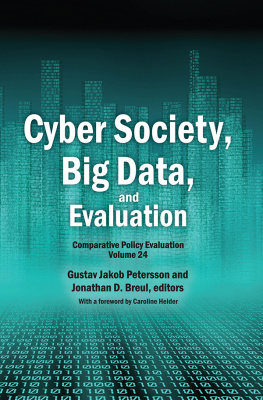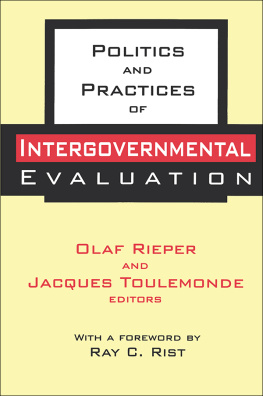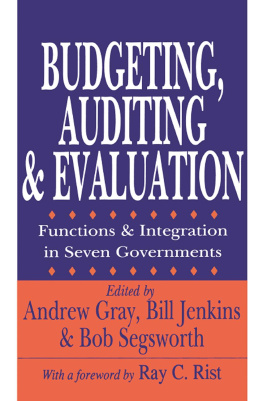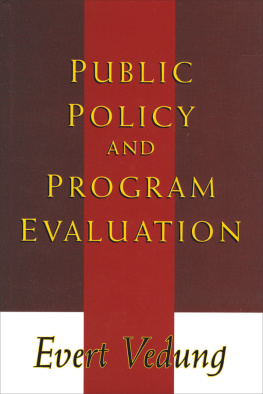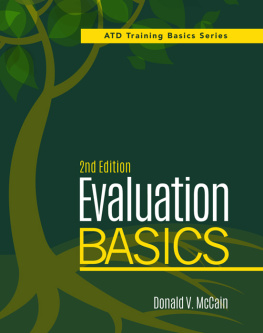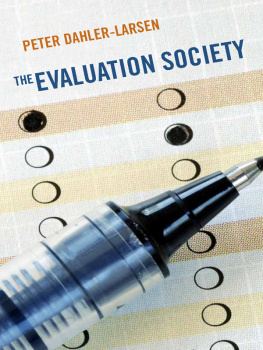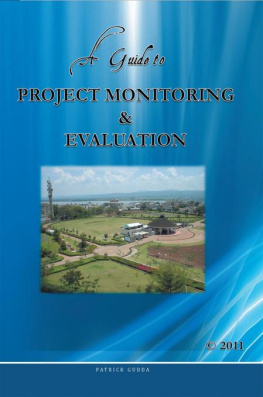First published 2017 by Transaction Publishers
Published 2017 by Routledge
2 Park Square, Milton Park, Abingdon, Oxon OX14 4RN
711 Third Avenue, New York, NY 10017, USA
Routledge is an imprint of the Taylor & Francis Group, an informa business
Copyright 2017 by Taylor & Francis.
All rights reserved. No part of this book may be reprinted or reproduced or utilised in any form or by any electronic, mechanical, or other means, now known or hereafter invented, including photocopying and recording, or in any information storage or retrieval system, without permission in writing from the publishers.
Notice:
Product or corporate names may be trademarks or registered trademarks, and are used only for identification and explanation without intent to infringe.
Library of Congress Catalog Number: 2016030729
Library of Congress Cataloging-in-Publication Data
Names: Petersson, Gustav Jakob, editor. | Breul, Jonathan D., editor.
Title: Cyber society, big data, and evaluation / Gustav Jakob Petersson and Jonathan D. Breul, editors.
Description: New Brunswick: Transaction Publishers, [2017] | Series:
Comparative policy evaluation; volume 24 | Includes bibliographical references and index.
Identifiers: LCCN 2016030729 (print) | LCCN 2016046182 (ebook) | ISBN 9781412864367 (hardcover) | ISBN 9781412864510
Subjects: LCSH: Big dataSocial aspects. | Social sciencesResearch. | Quantitative research. | Evaluation research (Social action programs) | Policy sciencesStatistical methods.
Classification: LCC H62 .C89 2017 (print) | LCC H62 (ebook) | DDC 303.48/33dc23
LC record available at https://lccn.loc.gov/2016030729
ISBN 13: 978-1-4128-6436-7 (hbk)
Comparative Policy Evaluation Series
Ray C. Rist, editor
The Comparative Policy Evaluation Series is an interdisciplinary and international series that evaluates governance issues from the perspectives of sociology, anthropology, economics, policy science, law, and human rights. Th e books draw from many diff erent nation-states and provide a longitudinal perspective: this series has been in existence for nearly thirty years and includes more than twenty volumes.
Titles in this series include:
Cyber Society, Big Data, and Evaluation
Doing Public Good?
Success in Evaluation
Speaking Justice to Power
Evaluation and Turbulent Times
Evaluation CulturesSense-making in Complex Times
Evaluating the Complex
Evaluation
Mind the Gap
Th e Evidence Book
Making Accountability Work
Open to the Public
From Studies to Streams
Quality Matters
Collaboration in Public Services
International Atlas of Evaluation
Building Eff ective Evaluation Capacity
Politics and Practices of Intergovernmental Evaluation
Contents
, by Caroline Heider
Gustav Jakob Petersson, Frans Leeuw, Jonathan Breul and H.B.M. Leeuw
Frdric Lefebvre-Nar, Sebastian Lemire and Gustav Jakob Petersson
Steven Hjlund, Karol Olejniczak, Gustav Jakob Petersson and Jakub Rok
Maria Barrados and Jonathan I. Mitchell
Frank Willemsen and Frans Leeuw
6. Using Big Data to Study Digital Piracy and the Copyright Alert System
H.B.M. Leeuw
Jonathan D. Breul
Peter Wilkins
Steffen Bohni Nielsen, Nicolaj Ejler and Maryanne Schretzman
Kim Forss and Jonas Norn
Francesco Mazzeo Rinaldi, Giovanni Giuffrida and Tom Negrete
Sebastian Lemire and Gustav Jakob Petersson
Gustav Jakob Petersson, Frans Leeuw and Karol Olejniczak
Foreword
Growing complexity and big data are reshaping the evaluation profession in fundamental ways. Increasing complexity is pushing evaluators to move from simple linear models to a more realistic way of evaluating development processes and their outcomes. The emergence of big data has the potential to help us overcome the perpetual search for more and better data, which is necessary to have a better, more robust understanding of change.
Cyber Society, Big Data, and Evaluation offers a visionary and insightful look at how societal and technological changes provide unprecedented opportunities and challenges for evaluators, in particular.
For decades, the evaluation profession has pointed to the need for more and better data. The cyber society now produces a constant stream of data, some through self-selected engagement with the Internet and social media, some because of data tracking built into devices we use on a daily basis.
This book shows how technological advances can help fill some of the data gaps that have hamstrung evaluation until now. Big data can usefully complement more traditional sources of evaluation data. It moves us away from the notion that data is generated only for the purpose of understanding a particular intervention, policy, or projecta linear results chainto recognizing that data on behavior change is much more dispersed and can capture a complex set of factors that trigger such change.
Furthermore, this book illustrates how technological advances in data processing exponentially improve our data processing capacity. This is important in light of the sometimes overwhelming quantities of data. New tools can help evaluators in identifying patterns and making sense of data that otherwise would be difficult to see. Importantly, these tools can also help us become nimbler, faster, and cheaper to address a long-running concern of policy-makers, namely that evaluators take too long to come up with evidence, analyses, and recommendations.
Technological advances allow uspolicy-makers, researchers, evaluatorsto test hypotheses in real time with very short feedback loops. Experimentation can help us understand how incentives change behaviors. The book provides illustrative examples of how this has and can be done.
The book also challenges evaluators to take up the opportunities that big data provides. The authors found that very few evaluators are tapping into big data or data science in meaningful ways. One example of how evaluators can do this is to provide data scientists with relevant evaluative frameworkstheories of change, hypotheses that can be tested against evidence, including from big dataand more traditional approaches. The authors have not been blind to the limitations of big data, but they validly point out the risks to the evaluation profession, if we dont seize the opportunities.
This book is a great resource that will stimulate debate and practice among evaluators, and hopefully in exchange with data scientists. It has the potential to ground evaluation in more evidence and make it faster than could be done with traditional means, if new technologies are adopted and adapted to complete current evaluation methods.

